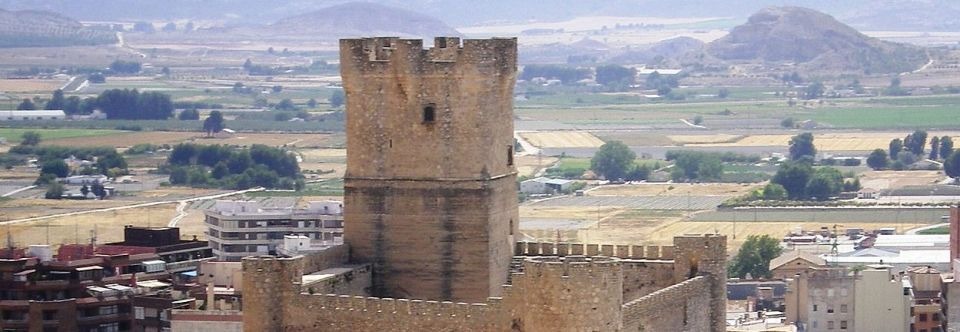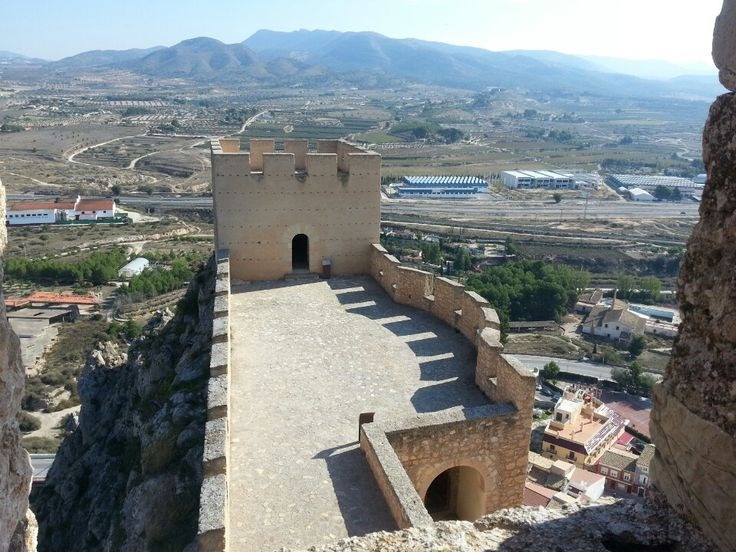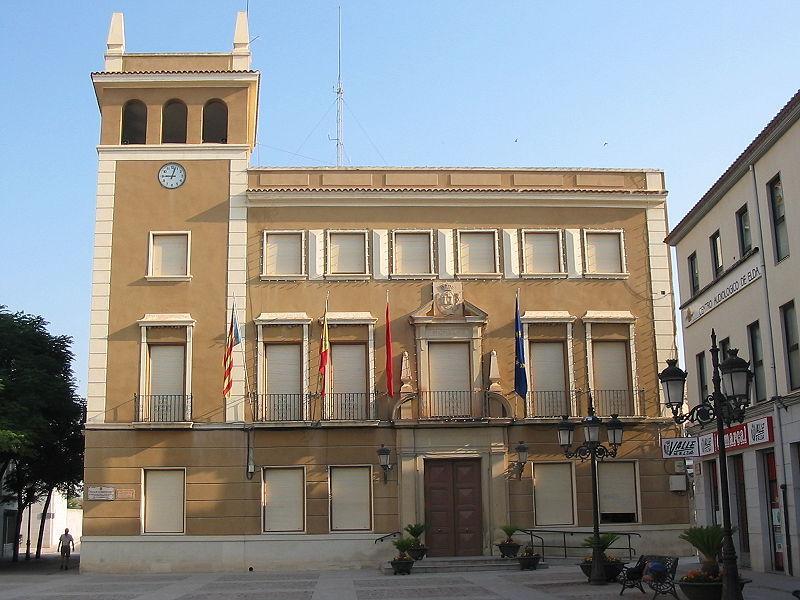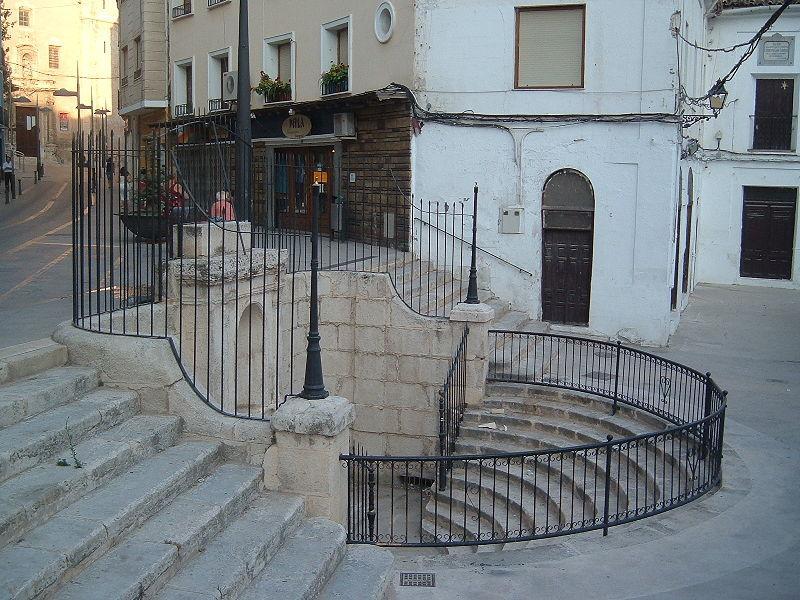Alicante, Comunidade Valenciana, Spain
Suggest Place to Visit
1606
Track to location with GPS |
 |
Prehistory
The oldest vestiges found in the municipality of Villena date back to the Middle Palaeolithic, approximately 50,000 years ago, and were found in the Cueva del Cochino. The continuation of the human process is in the place of the Huesa Tacaña (west of the Peña Rubia), being able to observe the cultural evolution in sites such as the Cueva del Lagrimal. Important remains of the Neolithic revolution were found in the Casa de Lara, representative of the Neolithic settlement in the plain, although the remains of this time flood the entire region: caves, the Vinalopó terraces, the shores of the old Villena lagoon, etc. However, the Neolithic period as it was short and in the strata considered eneolithic, there are already simple metallic objects, which already characterize the arrival of the Bronze Age, whose settlements are no longer found on plains but on strategic heights that are easily defensible. The caves that until then had been a dwelling place are beginning to be reserved for sepulchral purposes. Among the sites, due to the definitive irruption of urban planning, one of the main cities of the western Mediterranean stands out: Cabezo Redondo, which constitutes the border between Argaric culture and Valencian bronze. The development achieved in this stage has given Villena a privileged place in this period of history, since the set known as the Treasure of Villena belongs to this culture.
XIX century
In 1803 the Villena lagoon was ordered to be drained, from which 1704 ha of arable land were obtained. During the War of Independence, Villena was taken by Marshal Suchet, from the Napoleonic troops. To provoke the surrender of the few forces that defended the castle of the Watchtower, in 1811 Suchet bombarded it from the outside and, when taking the fortress, partially blew up the Almohad vaults of the keep, in order to render it useless for gambling a garnish. In 1836, after having previously belonged to the provinces of Murcia and Albacete, Villena was permanently incorporated into that of Alicante. With the construction, in 1858, of the railway that linked Alicante and Madrid and in 1884 with the route that connected it with Cieza and Alcoy (VAY), the rate of trade increased significantly and the first industries began to appear. [8] In the summer of 1888 the Torre del Orejón was demolished, thus eliminating the last piece of wall that remained in the city.
20th and 21st centuries
From the beginning of the century, the salaried and day laborer element acquired a strong weight that led to an important spread of anarchism and socialism, as evidenced by the events of the general strike of 1917, which resulted in deaths and injuries. [85] At the beginning of the Civil War, the Alicante authorities sent security forces to Villena and Almansa to prevent the rebellion from spreading to these cities. Even so, the first days of the war chaos reigned in the population, causing the greatest damage. The city was bombed on several occasions, in order to cut the rail connection between Madrid and Alicante. In 1937 an economic body was created, the Socialized Economy Regulatory Council, made up of elements of the UGT and the CNT, which administered the socialization of all the assets involved in the various productive and distribution activities. Given the shortage of fractional currency, the City Council was forced to issue currency. During 1939 the economic crisis worsened, which plunged the political activity of the city into a lethargic state that ended on March 29, 1939 when Franco's troops entered the city.
After the civil war, the situation in the city was critical, both economically due to the lack of supplies and the amount of destroyed infrastructure that had to be rebuilt slowly. Starting in the 1960s, a demographic explosion took place due to the arrival of immigrants, especially from Castilla-La Mancha and Andalusia. Thus, between 1960 and 1970 the urban area grew by over 20% and housing construction increased by 650%. On August 3, 1979, all the streets with a Francoist background were renamed. The current development of the city has a good cultural infrastructure, such as the Chapí Theater, the different museums, the Municipal Sports Pavilion, the various cultural events or the House of Culture, where one of the three libraries of the city is located, a room for theater and cinema and several exhibition halls. Also, along with the specialization of the economy, the service infrastructure has grown. The city has two industrial estates, the Rubial in the vicinity of the railway station and Bulilla in the A-31 highway, as well as other industrial areas in the main accesses of the city.
Villena is a city in the Valencian Community, Spain. Located in the northwest of the province of Alicante, it limits to the west with Castilla-La Mancha and Murcia and to the north with the province of Valencia. It is the head of the judicial district and capital of the Alto Vinalopó region. It is situated at an altitude of 504 meters above sea level and its municipal area covers an area of 345.6 km2 (which makes it the 2nd largest in the province). It has 35,222 inhabitants (INE 2009), being the 10th largest municipality in Alicante and the 21st in the Valencian Community.
There is evidence of settlement in the area since the Middle Paleolithic. However, it is disputed whether the current city dates from the Visigoth period or earlier, although it certainly existed in the 11th century, during the Arab period. After the Christian conquest, it became a Lordship, Principality, Duchy and finally Marquis, until the people, encouraged by the Catholic Monarchs, rebelled against the Marquis. In 1525 Carlos V granted it the title of city. This is the time of greatest economic prosperity, as shown by the monuments that have survived to this day. From the 16th century on, a period of tranquility began, only broken by the wars in which this area of Spain was involved. Despite the opening of a railway station in 1858, the economy remained essentially agricultural until the rural exodus of the 1960s. From then on, the economic model changed rapidly and today the economy is based mainly on the service sector. and industry, highlighting footwear, construction and furniture.
The city preserves an important historical complex, made up of its two castles and the various churches, hermitages, palaces and squares, as well as an important museum heritage, in which the José María Soler Archaeological Museum stands out. Among the main cultural events are the Moors and Christians festivities and the ´´Ruperto Chapí´´ Young Interpreters Contest.
Weather
Despite the proximity to the coast, the mountains represent an obstacle to receive the influence of the sea, and since the average altitude is above 500 meters, a peculiar harsh climate is conditioned. Villena has extreme temperatures that usually oscillate between -3 ° C and 35 ° C. In January 1915 -17.5 ° C were recorded, while on August 3, 1932, 42 ° C were recorded. For its part, the average temperature stands at 6 ° C in January, while in July and August it is around 24 ° C. Thermally, Villena presents the characteristics of a continental climate of the plateau, which is manifested in the existence of a true winter, and a summer in which there is an increase in temperatures in the central hours of the day with very refreshing nights.
The period of maximum rains is recorded during the spring and autumn months with very low levels: between 350 and 380 mm. The period between 1943 and 1962 yielded an average annual rainfall of 348.4 mm. Thus, the number of rainy days in autumn in Villena is, on average, 11, while spring is characterized by weaker or moderate rainfall. The high temperatures and the scarcity of rainfall, together with the irregularity of these, illustrate the aridity of the Villenense plain, which decreases as we approach the eastern part of Alto Vinalopó.
Ecology
Due to its great physiographic and fauna diversity, the natural heritage of Villena is of great importance in the context of the province of Alicante.
Flora
In the Sierra de Salinas is where the wooded vegetation -Mediterranean forest- is most abundant, conserving large areas of holm oak and dense pine forests. In other mountain ranges, with less arboreal vegetation such as Morrón and Peña Rubia, the scrub dominated by rosemary, juniper, juniper, thyme, gorse, etc., plants that are widely represented in these latitudes predominate. Within the municipality of Villena there are also substepular environments –zones of very low and cleared vegetation–, normally accompanying cereal crops, as happens in the Los Alhorines area.
There are three flora micro-reserves in Villena: since 1994 the Cabecicos de Villena Micro-reserve and the Cueva del Lagrimal Micro-reserve and since 2002 the Miramontes Micro-reserve.
Fauna
The Sierra de Salinas is the area with the greatest diversity of fauna in Villena, highlighting the genet, the wild cat and the wild boar and, among the game animals that inhabit the countryside, there is the rabbit and the partridge. Daytime and nocturnal raptors complete this relationship. The Lesser Kestrel has been reintroduced in the Alhorines area. In other areas of the broad term there are two unique species of birds in the province of Alicante: the Ortega and the Little Bustard. The presence of the common calender is very abundant, and of various types of pipits, while the curlew is more difficult to find. There are still humid areas in the Villena orchard, where amphibians and a fish known as fartet appear - very rare - whose only habitat is Morocco and southeastern Spain.
Parties
Moors and Christians: the Moors and Christians festival in Villena is celebrated from September 4 to 9 in honor of the patron saint of the city. It is one of the oldest and most massive of all the Moors and Christians festivals. Its origin dates back to 1474, when according to legend, the Virgin of Virtues, a lawyer against the plague, was proclaimed the patron saint of Villena. It is structured through the participation of fourteen comparsas, seven of them belonging to the Moro side and as many to the Christian side. The current Moors and Christians Festivities are the result of the fusion of three different festivals: the patronal feast or religious element, the military festival or boast, and the Moors and Christians festival proper or historical element.
Holy Week: organized by the Association of Brotherhoods, Holy Week in Villena is prior to 1850 according to the preserved texts. Holy Week begins in Villena on Dolores Friday, with the transfer of the steps to the Arciprestal Church of Santiago, from where the seven brotherhoods start in procession. Among the processions, the most prominent is the so-called ´Encounter Procession´ in which the image of Our Lady of Solitude and that of Our Father Jesus are finally united, a culminating moment that is accompanied by the singing of an arrow.
Cultural events
Young Performers Contest ´´Ruperto Chapí´´: held during the month of March to commemorate the birth of the composer. It is a national competition, one of the most prestigious in its field, which brings together in the city of Villena every year about one hundred musicians of up to 20 years from all over the country.
Festera Field and Crafts Fair: at the beginning of October, the Country Fair and the Festera Craft Fair are held at the Fairgrounds, with a large influx of people from all over the region. Parallel to this event, cultural and musical activities are carried out, with the performance of a group and with guided tours to get to know the city. The exhibitors show the public the latest developments in agricultural machinery, vehicles and festive crafts, with the exhibition of festive costumes and the corresponding complementary decorations and gifts with holiday motifs. Special mention deserves the exhibition of the agricultural cooperatives of the region, wineries and fruit and vegetable companies. On the days of the fair, traditional complementary activities are carried out, such as the tractor driver skill contest, the exhibition of dressage and hitching horses, along with exhibitions of other vehicles.
Medieval Market: It is a tradition since ancient times that the festival of San José is celebrated in the Rabal neighborhood, where this saint has his hermitage. Since 2001, the neighborhood, on the weekend before the festival, has been transformed with the necessary atmosphere and decoration to house the Medieval Market in its streets, where traditions and games of bygone times are represented. The ´´correfocs´´ parades are combined with falconry, guided tours and a whole series of stalls of typical and artisan products.
Film Week: it is one of the oldest cultural activities in Villena, since it was held for the first time in 1982. Without pretending to be a Film Festival, it tries to offer fans of the area to offer films of cultural interest and rigorous premiere in the Alto Vinalopó. The dates coincide between the first and second week of August.
Intercultural Week: it was created in 2004 as a result of the Plan for the Integration of Immigration in Villena. During the week there are courses, conferences, film and music exhibitions as well as the Humana fair. Its five editions have made it a benchmark for this type of event.
Folklore Festival: it is celebrated coinciding with the Day of Slavery, a local festivity deeply rooted in the population, carried out in the month of September. The first edition was in 1999. Currently it takes place in two days, on Saturday night in the Plaza de las Malvas and on Sunday morning in the Sanctuary of Our Lady of Virtues. A foreign group, a national group and two groups from the Valencian Community usually participate, in addition to the Villena Dance Group, which is the host group. It takes place, depending on the calendar, during the second or third weekend of September.
Thursday Market: this market is admirable mainly for its historical continuity. The privilege by which Don Manuel was granted the celebration of a free market every week is dated in Seville on May 18, 1266, and since then it has been held without pause every Thursday, which includes it within the markets with the most creation. ancient of Spain. Its location has been moving within the urban area from the Plaza Mayor to the Fairgrounds, where it is currently held.
Gastronomy
The typical dishes of Villena are characterized by being of humble and peasant origin, and therefore highly caloric to combat the cold of the region such as gazpachos from La Mancha, broad beans with artichokes, rice with rabbit, paella with leg and tripe or the triguico picao, among many others. This last dish also refers to a popular song that names the various ingredients that make it up. The vast majority of them are influenced by the gastronomic tradition of La Mancha and the Mediterranean.
It is worth highlighting the simplest dish, and perhaps the most appreciated of the people of Villena: the gachamiga. It is traditional for men to prepare it in a fire pan, with a long handle and placed on a trivet. In it, oil, garlic, flour, water and salt are mixed and it is stirred patiently until a kind of tortilla is obtained. It is usually eaten in the same pan and, as it is colloquially said, mojaíca and p'atrás, that is, taking a portion and leaving the turn to another diner.
In addition, the confectionery also has a good number of traditional pastas such as sequillos, wine rolls, almonds or toñas, which complement the culinary panorama of the city.
Wine
Villena has been dedicated to the cultivation of the vine and the production of wines since time immemorial. At the beginning of the 20th century, there were numerous wineries in the city, which exported their products by rail to the port of Alicante. Phylloxera in principle and the subsequent economic crises of the first third of the century (see: History of wine), together with the constant introduction of bottled wine, caused a reduction in the cultivation of the vine and the number of wineries.
Comments
We don´t have yet any comments about:
Villena
Villena
Be the first to leave a comment as it is very important to inform other people
Outros locais a visitar
Within a radius of 20 km from:Villena
Castle Atalaya |
| 0,9 Km |
 |
Sax Castle |
| 11,4 Km |
 |
Elda |
| 18,1 Km |
 |
Hotel reservation near Villena within a radius of 20 km
Why to book with ROTAS TURISTICAS
The best prices
Our partnerships with the world´s largest operators offer research on the best market prices.
More options
At Rotas Turisticos you can book the hotel, buy the air ticket, book the transfer from the airport to the hotel and vice versa, book the local excursions, rent the car, take travel insurance and consult the places to visit and where to go.
Holiday Tips & Destinations
Hundreds of holiday destinations with all the options that allow you to easily choose the destination that best suits your dream vacation.
ROTAS TURISTICAS
Links






